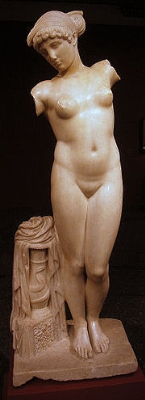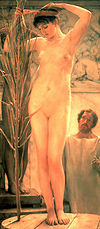
Esquiline Venus
Encyclopedia

History
It was found in 1874 in Piazza Dante on the Esquiline HillEsquiline Hill
The Esquiline Hill is one of the celebrated Seven Hills of Rome. Its southern-most cusp is the Oppius .-Etymology:The origin of the name Esquilino is still under much debate. One view is that the Hill was named after the abundance of holm-oaks, exculi, that resided there...
in Rome
Rome
Rome is the capital of Italy and the country's largest and most populated city and comune, with over 2.7 million residents in . The city is located in the central-western portion of the Italian Peninsula, on the Tiber River within the Lazio region of Italy.Rome's history spans two and a half...
, probably part of the site of the Horti Lamiani
Horti Lamiani
The Lamian Gardens were a set of gardens located on the top of the Esquiline Hill in Rome, in the area around the present Piazza Vittorio Emanuele...
, one of the imperial gardens, rich archaeological sources of classical sculpture. In the 16th and 17th centuries, the thirteen Medici Niobids
Niobids
In Greek mythology, the Niobids were the children of Amphion of Thebes and Niobe, slain by Apollo and Artemis because Niobe, born of the royal house of Phrygia, had boastfully compared the greater number of her own offspring with those of Leto, Apollo's and Artemis' mother: a classic example of...
, a variant of the Laocoön and his Sons
Laocoön and his Sons
The statue of Laocoön and His Sons , also called the Laocoön Group, is a monumental sculpture in marble now in the Vatican Museums, Rome. The statue is attributed by the Roman author Pliny the Elder to three sculptors from the island of Rhodes: Agesander, Athenodoros and Polydorus...
, the bust of Commodus with the attributes of Hercules, and the Discobolus
Discobolus
The Discobolus of Myron is a famous Greek sculpture that was completed towards the end of the Severe period, circa 460-450 BC. The original Greek bronze is lost...
had already been found here. After 1870 intensive building work was ongoing at the site to make Rome ready as Italy's capital, following the Risorgimento. The newly-found sculpture soon passed into the collection of the Capitoline Museums
Capitoline Museums
The Capitoline Museums are a group of art and archeological museums in Piazza del Campidoglio, on top of the Capitoline Hill in Rome, Italy. The museums are contained in three palazzi surrounding a central trapezoidal piazza in a plan conceived by Michelangelo Buonarroti in 1536 and executed over...
, where it now resides, and is usually on display at its Museo Centrale Montemartini.
In style the Esquiline Venus is an example of the Pasitelean
Pasiteles
Pasiteles was a Neo-Attic school sculptor from Ancient Rome at the time of Julius Caesar. Pasiteles is said by Pliny to have been a native of Magna Graecia, and to have been granted Roman citizenship...
"eclectic" Neo-Attic
Neo-Attic
Neo-Attic or Atticizing is a sculptural style, beginning in Hellenistic sculpture and vase-painting of the 2nd century BCE and climaxing in Roman art of the 2nd century CE, copying, adapting or closely following the style shown in reliefs and statues of the Classical and Archaic periods...
school, combining elements from a variety of other previous schools - a Praxitelean
Praxiteles
Praxiteles of Athens, the son of Cephisodotus the Elder, was the most renowned of the Attic sculptors of the 4th century BC. He was the first to sculpt the nude female form in a life-size statue...
idea of the nude female form; a face, muscular torso, and small high breasts in the fifth-century BC severe style
Severe style
The severe style, or Early Classic style, was the dominant idiom of Greek sculpture in the period ca. 490 to 450 BCE. It marks the breakdown of the canonical forms of archaic art and the transition to the greatly expanded vocabulary and expression of the classical moment of the late 5th century...
; and pressed-together thighs typical of Hellenistic sculptures. Its arms must have broken off when the statue fell after the imperial park in which it stood fell into neglect after antiquity. They have been frequently restored in paintings (see below), but never in reality.
Subject

Venus (mythology)
Venus is a Roman goddess principally associated with love, beauty, sex,sexual seduction and fertility, who played a key role in many Roman religious festivals and myths...
(possibly in the form Venus Anadyomene
Venus Anadyomene
Venus Anadyomene was one of the iconic representations of Aphrodite, made famous in a much-admired painting by Apelles, now lost, but described in Pliny's Natural History, with the anecdote that the great Apelles employed Campaspe, a mistress of Alexander the Great, for his model...
), as a nude mortal female bather, a female version of the diadumenos
Diadumenos
The Diadumenos , together with the Doryphoros and Discophoros, are the three most famous figural types of the sculptor Polyclitus, forming three basic patterns of Ancient Greek sculpture that all present strictly idealised representations of young male athletes in a convincingly naturalistic...
tying up the hair with a fillet (see below). Its provenance has been characterized both as a Ptolemaic commission or as a copy of one, perhaps a copy commissioned by Claudius
Claudius
Claudius , was Roman Emperor from 41 to 54. A member of the Julio-Claudian dynasty, he was the son of Drusus and Antonia Minor. He was born at Lugdunum in Gaul and was the first Roman Emperor to be born outside Italy...
himself for the imperial gardens.
In modern art

Edward Poynter
Sir Edward John Poynter, 1st Baronet, PRA was an English painter, designer, and draughtsman who served as President of the Royal Academy.-Life:...
's Diadumene (1884). These both portrayed the statue's model binding her hair with a strip of fabric (as with the statue type diadumenos
Diadumenos
The Diadumenos , together with the Doryphoros and Discophoros, are the three most famous figural types of the sculptor Polyclitus, forming three basic patterns of Ancient Greek sculpture that all present strictly idealised representations of young male athletes in a convincingly naturalistic...
) in preparation for modelling for the sculptor or for taking a bath respectively. Poynter believed this to be the correct reconstruction partly because the remains of the little finger of her left hand are visible on the back of her head, suggesting that her left arm was raised to hold her hair in place, whilst the right hand wound the fabric. At the Museo Centrale Montemartini, the Esquiline Venus is now usually displayed behind a 'pool' (actually a glass floor panel) in tribute to this rendering.
Exhibitions
From December 2006 to February 4, 2007 the sculpure was the centrepiece of the exhibition "Cleopatra and the Caesars" at the Bucerius Kunst ForumBucerius Kunst Forum
-External links:* . Retrieved on 2009-10-08....
at Hamburg
Hamburg
-History:The first historic name for the city was, according to Claudius Ptolemy's reports, Treva.But the city takes its modern name, Hamburg, from the first permanent building on the site, a castle whose construction was ordered by the Emperor Charlemagne in AD 808...
, following which, from March to June 2007, she was at the Louvre for the Praxiteles
Praxiteles
Praxiteles of Athens, the son of Cephisodotus the Elder, was the most renowned of the Attic sculptors of the 4th century BC. He was the first to sculpt the nude female form in a life-size statue...
exhibition.
Cleopatra?
- Das Gesicht der Göttin., 16.10.2006, Der SpiegelDer SpiegelDer Spiegel is a German weekly news magazine published in Hamburg. It is one of Europe's largest publications of its kind, with a weekly circulation of more than one million.-Overview:...
. Hamburg 2006, 42, S. 181 - Berthold Seewald, So sah Kleopatra wirklich aus, Die WeltDie WeltDie Welt is a German national daily newspaper published by the Axel Springer AG company.It was founded in Hamburg in 1946 by the British occupying forces, aiming to provide a "quality newspaper" modelled on The Times...
, 26 October 2006 (in German)http://www.welt.de/data/2006/10/26/1086381.html - Bernard Andreae, Dorothea Gall, Günter Grimm, Heinz Heinen et al., "Kleopatra und die Caesaren", hrsg. von Ortrud Westheider, Karsten Müller (2006: Munich, Hirmer Verlag)
- Cleo Uncovered (exhibition review of "Cleopatra and the Caesars"), Current World Archaeology 20, pages 42–43
External links
- Buffalo - more images, including back view
- The Victorian Nude
- Indiana - images (specifically here and here).

